
Grant Wood
“Imperialism is nothing other than the totality of the economic, political, and military means mobilized to produce the submission of the peripheries, today as yesterday.”
Samir Amin
“It was a street-show that had an ideology of conformity at its heart; to consumerism, commodified emotion and a shared experience of pre-chewed sentimentalised joylessness disguised with a perfect-toothed smile. Individually, the images are what they are. Photographers have to make a living. Collectively, this spittling drizzle of photographic normality and drab betrayed the fear, dishonesty and essential conservatism that lies at the heart of so much photography, art direction and buying; every one of these pictures was a lie. Not deep down a lie, but on the surface a lie… These are photographs that are numb, with no emotion, no opinion and no value.”
Colin Pantall
On Photographic Muzak
“The evaluation of audience desires, and the creation of content to meet those desires, has increasingly been ceded to machines and their algorithms. This has been done in an attempt to sand down some of the rough, unpredictable edges that in the past would nonetheless appear under the regime of commercial culture. Few cultural projects are now undertaken without seeking to model away all of the risk involved using the tools afforded by algorithms and the ability to quickly survey a large audience.”
Michael Pepi, William O’ Hara, and Dan Monaco
“Something of art has ended. The debate is not about the fact, but about its significance.”
J. M. Bernstein
There has been a reasonable amount of media coverage of the art auctions in New York this last month. Fifteen billion dollars changed hands. When you examine the work, what is most clear is that almost all of this stuff is branded. Roy Lichtenstein is a very effective brand, almost an ur-brand. Warhol, too, of course. But others, Alex Israel, or Richard Prince, as almost random examples, are mostly pure brand, too. Dead artists of course are in another class almost. Death is like re-branding. But the point is, amid this financial orgy of Christie’s and Sotheby’s auctions and sales were terrific artworks. Still, the branding is what people remember, and the context in which an artwork, lets say a painting, is experienced is so mediated by Capital, by financialization, by marketing and art dealers that it leads to very contradictory and complex emotions. And one by-product of this is the inevitable snark of a generation for whom art is essentially business. This leads me to another thought, which has to do with the near absolute failure of today’s audience for art overall, but especially (not surprisingly) for film and TV, to escape the confines of their own self authorized amnesiac present. A present in which they gobble up stuff, issue empty edicts and opinions, and move along to consume more, shop more, and forget more. Snark youth, compulsive middle aged shopper, both are feeding at the same polluted trough.
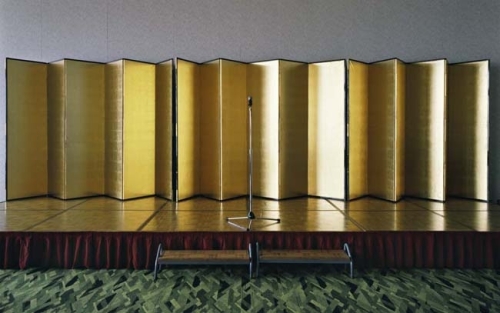
Karen Borghouts, photography.
So I will begin with a long digression. I happened to screen Kiss Me Deadly this week for some students. A friend of mine, Joe Nava wrote something about it, having watched it himself again. And what he said, which was very smart, reminded me of how empty and shallow are most discussions of film today. There are three films (I could probably find three others, in fact, but these work well for the purposes here) that share a common thread, and also are marked in very specific ways by the times in which they were made. Criss Cross (Robert Siodmak, 1949), Kiss Me Deadly (Robert Aldrich, 1955) and Point Blank (John Boorman, 1967). But one has to go back further, I think, before talking about each film. Back at least to the 19th century novel. The expanded narratives of Dostoyevski, Melville, Flaubert, Eliot, Tolstoy, Conrad, Stendhal, Dickens, and Turgenev, were distillations of the bourgeois life, as well as negations of it, or partly so. By the 20th century perhaps only Kafka matters at all among novelists. If that’s even what he was. The avant garde(s) of the early 20th century had, almost of necessity, rejected this form, or least rejected and recuperated, and reinstated in partial ways, the idea of the novel. But mostly there were anti-novels. Bernhard and Broch, and Beckett and Genet and Burroughs and Rulfo. Brilliant, but difficult. And therein lies another topic…and more on that below. But film, photography, and radio were changing the ways people, the audience, engaged with artworks, with narrative in particular. And it was to film, I think, that the novel migrated. At the same time, there were massive forced migrations of humanity. Never before in history had so many people been driven from there homes. The front edge of this of course began with the slave trade that peaked a century and a half before. The figure of the exile looms very large by the end of WW1. And with the exile, an idea of homesickness. Of loneliness as well, and of place. Or rather, those without a home, without a place. The vast majority of forced migrations were of people without a voice, or at least not one heard in the European world — and by extension then, the U.S. But those unheard voices did rise up like a psychic ground water, and they became the ghosts that haunted the storytelling of the first world. In the movie industry, there were exile directors, German Jewish emigres mostly, who came to Hollywood steeped in a Vienesse psychoanalytic culture, with a Germanic sensibility and art history. Robert Siodmak was one of them, with his brother Curtis. Criss Cross, his best film (though Phantom Lady is close, as is the rarely screened File on Thelma Jordan), is about a man (Burt Lancaster) returning to his old neighborhood. As it happens, Bunker Hill in Los Angeles. It is 1949. The war has been over five years.

Invasion of the Body Snatchers (1956). Don Siegal, dr.
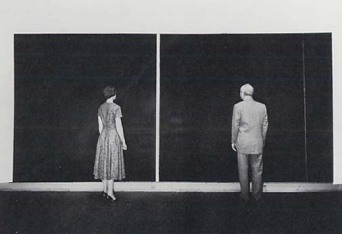
Barnett Newman and unidentified woman in Newman’s studio, 1958.
The sense of loss, of homesickness, is palpable in almost all of the classic noirs from the 40s. The figure of the private eye, though in truth perhaps only half — if that — of 1940s noirs featured P.I.s, was the Knight Errant, the seeker of truth. This also, of course, dissolved in the glare of the garish technicolor films of the mid 50s, and in the cynicism and gradual but inexorable drift to the political right of the society. The madness of the bourgeoisie was now starkly revealed.

Merijn Koelink, photography.
Those 1950s B films, the so called *sun lit noirs* were the mannerist phase to the classic era of the forties. But there were other elements worth examining in narrative here. The literature of the mid 20th century, in English, began to exhibit some of the pathological denial of the society as a whole. The manufacturing of a Norman Rockwellian Ozzie & Harriet world, Queen for a Day and Father Knows Best and Dwight Eisenhower…and Joe McCarthy. Its all of a piece. The anti communist hysteria was the moral sickness of the society. The artist retreated to the avant garde more as refuge, and in painting the Marxist immigrants of the New York School (most anyway) looked to find the outer edges of form, but also of the spiritual. The retreat from Abstract Expressionism was into the strategic careerism of the mannerist mini movements that followed in reaction. It is becoming increasingly difficult, I think, to appreciate art. A visit to the Modern in New York means an hour of bombardment by image and noise during the travel to get there. The museum itself, like almost all museums today, is ever closer to a visit to a corporate headquarters where an amusement park has been built on the side for the rubes to visit. Audiences are treated as children, and increasingly they ARE children. The infantilization of the society is nearly complete. The sense of grandeur and taste, of sensitivity to color and tone, that one finds in Barnett Newman, for example, is hard to see anymore. Its there, but from all sides there is a caustic snide attitude. Leftists never tire, NEVER tire of pointing to the CIA’s brief and well documented minor pimping of the Ab Ex painting. Its like a secret handshake for leftists. There is some cool factor attached. For the right, everything is junk. Everything not military. Not patriotic. But for the majority of those in the U.S. and U.K. there is ever less interest given to *art*. There is a lot of interest in *entertainment* but not in art.
And the abandoning of art, as a practice, as an idea, is also an abandonment of..as J. M. Bernstein put it: “its function as a form of resistance, a reminder, a placeholder, for the claim of sensuous particularity, and so nature, against the claim of self authorizing mindedness.” There is, I continue to find, a numbing sense of mediocrity in western culture today. I know very few good teachers, because most who have any ideals or commitment, retire early. I know artists who have been destroyed, both mentally and spiritually. And I think this is because of the specific ways in which the Spectacle seeks out the most anodyne and empty and then goes on to promote that. The unexceptional is the ideal now, not the median. And the collective sense of raised consciousness that occurred in the sixties has been all but extinguished. From Malcolm to the Panthers, to Jackson Pollock, to Genet and Beckett, to that sense of film art that was being driven by European directors mostly: Pasolini, Antonioni, Fassbinder, and Godard, even to Bergman, or Losey, the mid century through to the mid 1970s, contained radical voices. It also contained working class voices. That is not true today. The corporatized scheme for education includes class segregation. Anyone who does not see the corruption and class prejudice in Academia just isn’t looking. And of course marketing, and Hollywood have intensified their message. A message that is flagrant and unalloyed in its fascist sentiments.

Jeff Silverthorne, photography.
I suspect that if one systematically looked back, historically, at cultures all over the world, you would find that the role of the artist ended in some form of solitude and isolation. The community cannot really tolerate the artist for too long. He or she is the disrupting force of change, the reminder of personal trauma, and of both shame and guilt, as well as desire. But the artist must not seek other than isolation and exile. The older artist who is *not* shunned, in a sense, is the collaborator.
There is a sense in which even wildly successful and recognized artists will withdraw. This is the natural structural process, as well as the natural spiritual one.
The problem today is that aesthetic negation, and this relates to aesthetic autonomy; that which makes something aesthetic, and by comparison, everything it is not, as not aesthetic, is increasingly difficult to differentiate not because *everything* can or is art, but because NOTHING is art, and nothing can be art. Its not the inclusion of things, its the exclusion of possibility.

Mary Devens, photography. 1897.
Pepi and O’Hara and Monaco conclude their very cogent little essay this way:
“The complicity of the consumer in his own debasement is wholly on display in this state of affairs. New cultural mechanics simultaneously promise to reward our participation (“because you wanted it, we made it!”) and threaten us if we opt out (“we don’t want to make things that you don’t want to do, but how do we know what you want if you don’t participate?”). In the end, consumers are enjoined to do more work to create less substantial works that profit concentrations of capital in which they have no stake.”
This is the logic of conformity. It is the erecting of an idea of conformity as a virtue. And that conformity is joined at the hip to globalized Capital.
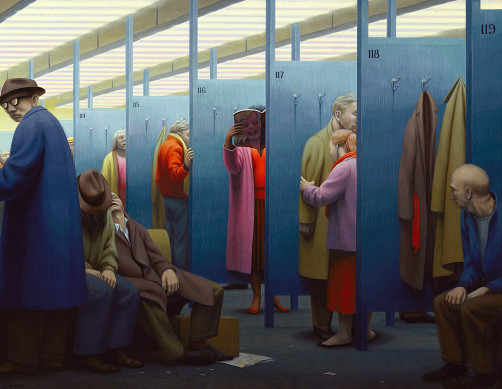
George Tooker
It is conformity of obedience, and a constant message of encouragement in one’s own domination. Many liberals, at least white liberals, will scoff at words like *domination*. How can I be dominated if I just bought a new iPhone? The fact is that shopping, online or off, is very close to the state religion in the U.S. Its acute in parts of Europe certainly, but nothing like the U.S. Perhaps that has to do with two things: Puritanism and Imperialism.
The new opportunism of the celebrity left (sic), those corporate employed crypto Imperialists (Laurie Penny, Molly Crabapple, Natasha Lennard, and really, Paul Mason, and Danny Gold, and all the rest who pimp for U.S. military solutions, and there are a host of others) have reached a zenith of bad faith, cynicism, and ethical turbidity, obfuscation, and just naked dishonesty, in this http://interactive.fusion.net/rise-up/index.html
The new marketing of revolution. Branded, capitalized, and very troubling. This is an extension, really, of what I wrote about last posting. The appropriating of human suffering, compiled by algorithms, market tested, and very effective mind control, finally. For the effects of these enterprises are to re-program expectations, and then bait and switch the narrative theme. Suddenly, the audience, the subject, is applauding and helping and assisting something quite different than the first advertising blitz promised. Keep your eye on the ball. Its three card monte for generation duh. For the record this is a Disney/ABC/Univision(right wing media folk who assisted the coup in Venezuela in 2004) project. Haim Saban is a lead shareholder, and a big supporter of Israeli policy. Isaac Lee Possin, a Colombian educated in Israel is the chief executive for Fusion. This is the corporate structure now creating politics as spectacle. Throw enough money around, enough swag, and enough contradiction, and repeat it ad infinitum, and eventually the audience fatigue stops critical thinking.
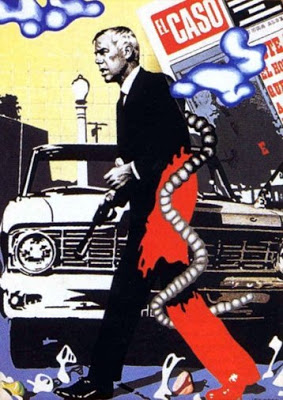
Rafael Solbes
But back to art.
The moment Warhol and Lichtenstein created ‘Pop’ art, the entire issue of autonomy was raised and reconstituted the meaning of art. I dont actually think one can lump minimalism into this same basket, but the point here is that ideas about symbol and allegory changed. Or perhaps, more correctly, were erased. For now ‘anything’ was art and history was irrelevant. Critics could write about ‘the end of art’. Arthur Danto saw in Pop Art the impossibility of any longer distinguishing between an aesthetic object and an ordinary object. But this implies that cultural history was only about such distinctions. So, in another sense, this was a de-politicizing of art and culture. For Adorno was right, it was the spell cast by the artwork that mattered. And it was in Adorno’s critique of The Odyssey that he confronted a chthonic underside to storytelling, to myth, and to the role of, and formation of, culture and art. For in language itself, there was history (in fact Adorno’s criticism of Heidegger was predicated on what he saw as fraudulent pseudo magical interpretations of invented words). This was what Hegel, and then Marx, and then Benjamin and Adorno himself terms *Natural History*. And it is this cultural process of exhumation that modernist art (and probably medieval art in a different sense) were pursuing. And everything created must address this, even as the self must exhume its own process of becoming. This probably goes far beyond the issues I want to focus on, but it’s important to understand exactly what the Spectacle, the post-cultural moment of mass electronic screen culture has destroyed. Or is trying to destroy. For Heidegger, like Hegel (and Marx certainly saw this when he critiqued Hegel) is valorizing the *now*, the status quo, albeit a narrow Volkisch *now*. It is culmination. It is a claim to totality that is the fraud. In the three films mentioned above, each is echoing Homer, and each is finding a problematic, even nihilistic absence at the end of the journey. There is no, and can be no, culmination.

The Student of Prague (1913). Paul Wegener, Stellan Rye, Hanns Heinz Ewers directors.
This absence though is the foundation for allegory. For Adorno, this was the history of subjectivity being played out again and again. And the claims to totality are the destruction of mimesis. In other words, the primordial mimetic identification (and here both Freud and Lacan are contributing factors) with rivalry, with aggression, must result in sublimation, and in forgetting. “Meaning is the ruins of Nature”, Hullot-Kentor.
“Art’s truth appears guaranteed more by its denial of any meaning in organized society…” Adorno.
Those who deny meaning in art, or claim an end to art, are justifying the instrumental logic of domination. Art’s purpose lies in its lack of purpose, for then the mystery and illusion achieve autonomy — the erasure of differentiation is the belief in an objectivity and truth of a society that dominates and pacifies and alienates. But yet, in which everything can be meaningful. In which everything IS meaningful. The presentation of advertising, Campbell’s soup cans, as art was actually a destruction of the object. All objects can be famous for fifteen minutes, and hence all objects are fungible. And if that is so, then a specificity of object is lost. Hans Sedlmayr in the 1920s said lifeless objects can acquire a face and gaze back at you. This is related to Von Kleist’s essay on marionettes. It is *ausdruck*, the gaze of the artwork, and it is found only in the non-fungible.

Alfred Leslie
And the problem with this post historic art is that if objects are fungible, then so are people. The suffocating deadness found in *artists* like Koons or Marina Abramovic, speaks to this underlying sense of human disposibility.
Mimesis is a contested term in Adorno. And in Benjamin. For it means different things in different contexts. But none contradict the other. There is the primordial linkage to imitation, and there its secondary role in survival, and then there is the psychoanalytic form which is akin to projection. Andreas Huyssen actually laid out five distinct meanings of the word *mimesis* that he found in Adorno. But the last one is really Benjamin’s use or definition, and it has to do with Benjamin’s linguistic theory. And that would require an entire other post. The salient aspect of his theory is that there are several registers in which language has meaning. And the utterance of words is connected to the body, to a gestural knowledge, which again relies on the sensual as formative. The 1920s in Austria and Germany were keenly exploring ideas of how expression took on meaning, and Benjamin was one among many who grappled with this under the sway of Freudian theory and practice. The point though is mimesis is partly a sensual knowledge, and its practice provides extra-linguistic meaning to utterance. Benjamin wrote a good deal on film and photography during these years. For he sensed, rightly, that in film there was another sort of space, another sense of time, and more, a deep mediating of mimesis in the audience. For Benjamin saw two basic registers of language: one was instrumental, logical, the manipulation of signs and the other was as knowledge of mimesis. Benjamin saw mimesis, always, more closely aligned with similarity than did Adorno. In other words, language as sign, language as image (hieroglyphs) and language as a very particular kind of imitation of Nature. It is this last meaning that remains so difficult. But it is the one most relevant in an age of screen dominance. For in mass kitsch culture, in which the *now* is being reproduced ever more rapidly, constantly, there is no Nature returning our gaze.

Atul Dodiya
Adorno wrote that art is a form of behavior. For that is mimesis, too. And even when utterly subjective, and perhaps it is always partly subjective in this sense, the mimetic engagement must have something with specificity to provide refuge (another words of Adorno’s). I suspect those memory traces of archaic mimesis have all but been eliminated today. The differences between not just an aesthetic object and a not aesthetic object matter, but between our memory and our separation or not from other people. The knowledge of the human is gained through mimetic processing. Without it, the culture increasingly functions in ways close to how autistics function. But more, when only a screen gazes back, that is no gaze at all.
“The survival of mimesis, the non-conceptual affinity of the subjectivity produced with its other…defines art as a form of knowledge…For that which mimetic behavior addresses is the telos of knowledge…art contemplates knowledge with what is excluded from knowledge…”
Adorno
This occurs in painting, in photography, and it occurs in narratives. On stage, in film, in novels, anywhere. It is the raison d’etre of art. Today, the instrumental straightjacket that binds all expression is also found in the endless pseudo scientific drivel one reads or hears in media. Dietary advice, or psychological bromides, or moral posturing is always baked in the ovens of mock science. It is not science, it is not even magic. But from this comes cultural expression that is equally banal and lifeless. Whatever else, there was life in Criss Cross, and before that, to visit again the German Expressionist cinema, is an almost shocking experience… for there is memory and dream, and gestural knowledge (The Student of Prague, The Golem, The Cabinet of Dr. Caligari, Nosferatu, Shatten, et al). None of that exists in today’s corporate mass culture. Gone Girl or The Hunger Games possess no mimetic memory. They are literally distracting audiences from remembering…anything. The society is awash in sleight of hand intellectual games.
The tensions that are expressed in those three films I listed above, were from a sense that something was being lost. The best contemporary film seem always to be connected to a dream of retrieval. The worst contemporary film is comfortable with amnesia.

Ron Bladen
The idea of an end to art already resided in Duchamp, and later in Rodchenko. Except of course it doesn’t end. And it can’t end under the terms of these experiments. The theoretical gestures, the ready-mades, the black painting of Malevich, were finally pointless. It was not until Warhol, really, and Lichtenstein, that the focus shifted to the commodity. The problem with all of this is that in a sense, the mass culture of giant telecoms, Hollywood, and the pop music business, has moved the goal posts, so to speak. It isnt art that is destroyed, it’s the audience. It is the society of scale and proportion as aspects of a morality. Art isn’t dead, but probably the collective memory of Western culture is. Post modern ideas about the arbitrary sign or symbol, are in collusion with the residue of Hegelian/Heideggarian insistance on the whole. The whole being the totality of social experience, and argued as a form of self realization, self improvement, individuality, and … finally, progress. Call it something else, but hiding behind every piece of Jeff Koons junk is the wink and nudge of self congratulation. In the same way that film, that artform born of seaside amusements, and developed almost from the start as a business, is forever looking to pat it self on the back via gratuitous awards shows and constant media hype. This is called populist exactly because its the least populist artform in existence.
Art is self destructive. It is guided by impulses that are anti social, but only in so far as they question the status quo, because the status quo cannot survive history or memory. I doubt anyone would claim Kiss Me Deadly is exactly Shakespearean in scope or magnitude of emotion, but it survives viewing today because it refuses to deny it own destructive character. And within that declaration of defiance, even if subsumed by the film industry to a degree, are found the echos and traces of history, the understanding that you cant have gotten here without suffering, inequality, and madness. Only the most privileged claim sanity.
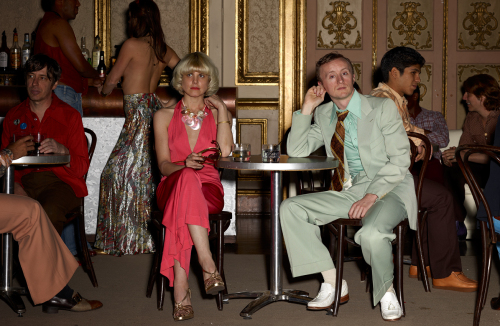
Stan Douglas, photography.
Painters like Barnett Newman or Mark Rothko, are reducing an idea, on the one hand, but it is in their secret disposition, the enigmatic and hidden, that they are actually looking for plenitude. You cannot be enigmatic without being allegorical. Even the stripe of Newman reach toward the allegorical. I’d say it’s a good rule of thumb to distrust art that requires elaborate pre conditions for viewing it (or hearing it, etc). If you have to don headphones, or walk through a tunnel, then its probably just a sales pitch tricked out as socially relevant. Never trust social relevancy anyway, not in art. The importance of art lives in a mimetic memory, one that perhaps was once more active, but now is found in art. Why else bother? The deceit and ruthlessness of American society today, the inauthentic and counterfeit that exists in the non stop assault of advertising is only salved by reminders that being human doesn’t have to be a quest to become reptile, but that humaneness is the spiritual and psychological sacrifice that goes into genuine expression.

I just re-watched Out Of The Past. (Brando should’ve emulated Mitchum instead of Paul Muni, but that’s another kettle of fish). I think there is indeed a sort of Shakespearean flavor to the good Noir flicks; undeniably popular genre entertainments that excel themselves. The severe constraints of technology, budget, and the Code wound up being part & parcel of the classic Noir mystique and appeal; nowadays even with a tip top cast & script we’d be forced to– as The Kids say– literally see subtext, see between scenes & lines, explanations & graphic violence galore when the implicit is infinitely more unnerving than the explicit. So much of the power of Noir (and Shakespeare come to that) is the very lack of spoon fed cant even as, somewhat paradoxically, the fatalism is a given.
The great Ian Bostridge…
http://www.theguardian.com/commentisfree/2014/nov/21/search-liberal-eduction-disciplines-inspirations-newton
listening to some beautiful music to counteract the ugliness of what has happened in the past days in the US.
John, after a long week of friends visiting from out of town, I can finally take pleasure in catching up with your writing. Happy autumn, friend. Always a pleasure! And I’m flattered to be mentioned by you.
Your breakdown of mimesis is exceptional, as I’ve often strived to break down the word to the essence of its meaning, especially since it’s an idea I recognize while watching film or reading literature. I need to think about it some more, so I’ll keep my thoughts brief, but they build on your comments re: Benjamin’s ideas on mediating mimesis in film. I do believe that time and space in film are so incredibly malleable that they import/impose their own sense of mimesis on its audience… As Godard said, the audience is being thought. Again, this manipulability, when done well, imitates a fractured image of Nature, almost a new dimension of perception that allows the audience to have an omniscience in an imitated reality. I believe this is all due to editing, to the cut, something music in its rhythms and painting in its form cannot possess. The cut itself is paradoxical because it breaks space and time, but by doing so it transports the audience into a mimetic world of the director. I need to think about this more, and perhaps read up on Benjamin, but these ideas are fascinating to me.
As I’ve said before, even if I’m a few days late or if I don’t comment, I always read your writing. Sometimes it’s best to absorb and reflect on the ideas presented than to feel the need to add something meaningless. Salud!